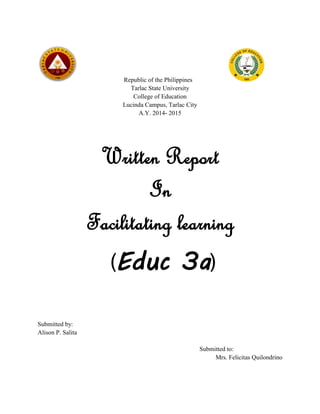
Characteristics and learning styles of gifted children
- 1. Republic of the Philippines Tarlac State University College of Education Lucinda Campus, Tarlac City A.Y. 2014- 2015 Written Report In Facilitating learning (Educ 3a) Submitted by: Alison P. Salita Submitted to: Mrs. Felicitas Quilondrino
- 2. General Behavior Characteristics of Gifted Children Gifted children’s behavior differs from that of their age mates in the following ways: Many gifted children learn to read early, with better comprehension of the nuances of language. Gifted children often read widely, quickly, and intensely and have large vocabularies. Gifted children commonly learn basic skills better, more quickly, and with less practice. They are better able to construct and handle abstractions. They often pick up and interpret nonverbal cues and can draw inferences. They take less for granted, seeking the “how’s and “why’s”. They can work independently at an earlier age and can concentrate for longer periods. Their interests are both wildly eclentic and intensely focused. They often have seemingly boundless energy, which leads to misdiagnosis of hyperactivity They usually respond and relate well to parents other adults. They like to learn new things, are willing to examine the unusual and are highly inquisitive. They like to learn new things, are willing to examine the unusual, and efficient manner. They exhibit an intrinsic motivation to learn, find out or explore and are often very persistent. Learning Characteristics of Gifted Children Gifted children are natural learners who often show many characteristics: • They may show keen powers of observation and a sense of the significant • They may read a great deal on their own, preferring books written for children older than they are. • They often take a pleasure in intellectual activity. • They have well-developed powers of abstraction, conceptualization, and synthesis. • They readily see cause-effect relationships. • They often display a questioning attitude and seek information for its own sake as much as for its usefulness. • They are often skeptical, critical and evaluative.
- 3. • They often have a large storehouse of information about a variety of topics which they can recall quickly. • They readily grasp underlying principles and can often make valid generalizations about events, people, or objects. • They quickly perceive similarities, differences, and anomalies • They often attack complicated material by separating it into components and analyzing it systematically. Creative Characteristics of Gifted Children Gifted children’s creative abilities often set them apart from their age mates. These characteristics may take the following forms: • Gifted children are fluent thinkers, able to generate possibilities consequences or related ideas. • They are flexible thinkers • They are original thinkers • They can also see relationships among seemingly unrelated objects, ideas or facts. • They are elaborate thinkers. • They are willing to entertain complexity and seem to thrive on problem solving. • They are good guessers and can readily construct hypotheses or “what if” questions. • They often are aware of their own impulsivenes and irrationality, and they show emotional sensitivity. • They are extremely curious about objects, ideas, situations or events • They often display intellectual playfulness and like to fantasize and imagine. • They are sensitive to beauty and are attracted to aesthetic values Diversity in Learning • Diversity is the presence of a wide variation in qualities or attributes. • In social context, the term diversity refers to the presence in one population of a wide variety of cultures, opinions, ethnic groups, socio economic background, etc.
- 4. When we speak of diversity in the classrom, we usually focus on the diversity of the students in the room. We often forget that the teachers also bring a range of diversity issues to the classroom. Every teacher brings his or her physical appearance and culture into the room at the same time as students do. Some general strategies suggested to help teachers work effectively with the broad range of students enrolled in their classes (Davis, 1993) 1. Treat each student as an individual, and respect each student for who he or she is. 2. Rectify any language patterns or case examples that exclude or demean any groups. 3. Convey the same level of respect and confidence in the abilities of all your students. 4. Do not try to “protect” any group of students. 5. 5. Be evenhanded in how you acknowledge students’ good work. The wise person makes learning a joy; fools spout only foolishness. ~ Proverb 15:2, Bible "A child is not a vessel to be filled, but a lamp to be lit". ~ Hebrew Proverb
